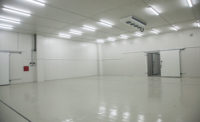In the food and beverage industry, sanitary design refers to the application of design techniques that allow the timely and effective cleaning of the entire manufacturing asset.
Randy Porter, senior director of food safety for the Acheson Group, says sanitary design improves food safety, helps companies avoid costly product recalls and provides operational efficiencies by reducing labor costs and the time and effort required to clean the equipment in the facility.
“Plant managers must be able to recognize that sanitary design not only helps support their food safety philosophy, but also supports the overall business philosophy,” says Porter.
Basic sanitary design principles
Porter says that when building a new food or beverage processing facility or renovating an existing space, it’s important to focus on these basic sanitary design principles:
• Raw separated from ready-to-eat: Keeping physical separation between the raw production side of the building and the ready-to-eat side of the building can prevent cross-contamination.
• Cleanable surfaces: It’s important to look for equipment that allows easy access and adequate space for cleaning.
• Smooth surfaces and corrosion resistant: In a wet environment, carbon steel framework on a piece of equipment doesn’t survive very long and can become uncleanable once rust gets inside.
• Self-draining: The equipment should continuously flow and not have spaces where product and liquid will sit and increase the chances of contamination.
• Proper ventilation: Ventilation and appropriately filtered air are essential to preventing the formation of condensation, odor or mold that could result in raw materials or food becoming contaminated.
• Proper material construction: It’s important to ensure materials are well-suited for the environment, whether it be wet or dry. For example, it would not be wise to use drywall in a wet wash-down environment.
• Framework not penetrated: Tubular steel equipment framework must be sealed and impenetrable to prevent it from collecting moisture and bacteria.
Electrical equipment in sanitary design
Many companies elect to renovate existing buildings to meet their needs in a cost-effective way. Advances in electrical systems that make this possible while also meeting sanitary design principles include:
• Stainless-steel cable management: Stainless-steel cable management systems offer good corrosion resistance against water and food products, meeting the requirements for the proper material construction sanitary design principle.
• Watertight plugs and connectors: Watertight plugs and connectors fall in line with the proper material construction and the corrosion-resistant sanitary design principles. Watertight compression cord grips and a multi-point sealing system between the plug and connector ensure protection from water and contaminants.
• Stainless-steel safety switches: Stainless-steel safety switches certified by the National Sanitation Foundation (NSF) are made with smooth, continuous surfaces to allow easier access as well as quicker, more effective cleaning. Safety switches designed with a sloped roof help facilitate runoff and minimize contaminant buildup.
• Wiring devices with antimicrobial protection: This type of wiring device has antimicrobial additives embedded into all polymer components, providing long-lasting protection against the growth of bacteria, molds, mildews and fungi, even if it is nicked, scuffed or damaged.
Renovating an existing food-processing facility with modern electrical systems and a focus on sanitary design can help prevent costly product recalls and create operational efficiencies and is more cost-effective than building a new facility. NP






Report Abusive Comment